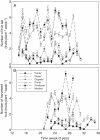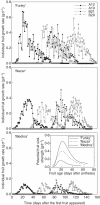Simulation of fruit-set and trophic competition and optimization of yield advantages in six Capsicum cultivars using functional-structural plant modelling
- PMID: 21097946
- PMCID: PMC3077981
- DOI: 10.1093/aob/mcq223
Simulation of fruit-set and trophic competition and optimization of yield advantages in six Capsicum cultivars using functional-structural plant modelling
Abstract
Background and aims: Many indeterminate plants can have wide fluctuations in the pattern of fruit-set and harvest. Fruit-set in these types of plants depends largely on the balance between source (assimilate supply) and sink strength (assimilate demand) within the plant. This study aims to evaluate the ability of functional-structural plant models to simulate different fruit-set patterns among Capsicum cultivars through source-sink relationships.
Methods: A greenhouse experiment of six Capsicum cultivars characterized with different fruit weight and fruit-set was conducted. Fruit-set patterns and potential fruit sink strength were determined through measurement. Source and sink strength of other organs were determined via the GREENLAB model, with a description of plant organ weight and dimensions according to plant topological structure established from the measured data as inputs. Parameter optimization was determined using a generalized least squares method for the entire growth cycle.
Key results and conclusions: Fruit sink strength differed among cultivars. Vegetative sink strength was generally lower for large-fruited cultivars than for small-fruited ones. The larger the size of the fruit, the larger variation there was in fruit-set and fruit yield. Large-fruited cultivars need a higher source-sink ratio for fruit-set, which means higher demand for assimilates. Temporal heterogeneity of fruit-set affected both number and yield of fruit. The simulation study showed that reducing heterogeneity of fruit-set was obtained by different approaches: for example, increasing source strength; decreasing vegetative sink strength, source-sink ratio for fruit-set and flower appearance rate; and harvesting individual fruits earlier before full ripeness. Simulation results showed that, when we increased source strength or decreased vegetative sink strength, fruit-set and fruit weight increased. However, no significant differences were found between large-fruited and small-fruited groups of cultivars regarding the effects of source and vegetative sink strength on fruit-set and fruit weight. When the source-sink ratio at fruit-set decreased, the number of fruit retained on the plant increased competition for assimilates with vegetative organs. Therefore, total plant and vegetative dry weights decreased, especially for large-fruited cultivars. Optimization study showed that temporal heterogeneity of fruit-set and ripening was predicted to be reduced when fruits were harvested earlier. Furthermore, there was a 20 % increase in the number of extra fruit set.
Figures







Similar articles
-
Genetic differences in fruit-set patterns are determined by differences in fruit sink strength and a source : sink threshold for fruit set.Ann Bot. 2009 Oct;104(5):957-64. doi: 10.1093/aob/mcp181. Epub 2009 Jul 30. Ann Bot. 2009. PMID: 19643909 Free PMC article.
-
Correlation between dynamic tomato fruit-set and source-sink ratio: a common relationship for different plant densities and seasons?Ann Bot. 2011 Apr;107(5):805-15. doi: 10.1093/aob/mcq244. Epub 2010 Dec 23. Ann Bot. 2011. PMID: 21183453 Free PMC article.
-
Flower and fruit abortion in sweet pepper in relation to source and sink strength.J Exp Bot. 2004 Oct;55(406):2261-8. doi: 10.1093/jxb/erh245. Epub 2004 Aug 27. J Exp Bot. 2004. PMID: 15333643
-
Hormonal and metabolic regulation of source-sink relations under salinity and drought: from plant survival to crop yield stability.Biotechnol Adv. 2014 Jan-Feb;32(1):12-30. doi: 10.1016/j.biotechadv.2013.10.005. Epub 2013 Oct 25. Biotechnol Adv. 2014. PMID: 24513173 Review.
-
Source-sink interaction: a century old concept under the light of modern molecular systems biology.J Exp Bot. 2017 Jul 20;68(16):4417-4431. doi: 10.1093/jxb/erx002. J Exp Bot. 2017. PMID: 28338782 Review.
Cited by
-
Quantification of light interception within image-based 3-D reconstruction of sole and intercropped canopies over the entire growth season.Ann Bot. 2020 Sep 14;126(4):701-712. doi: 10.1093/aob/mcaa046. Ann Bot. 2020. PMID: 32179920 Free PMC article.
-
Exploring natural variation of photosynthetic, primary metabolism and growth parameters in a large panel of Capsicum chinense accessions.Planta. 2015 Sep;242(3):677-91. doi: 10.1007/s00425-015-2332-2. Epub 2015 May 26. Planta. 2015. PMID: 26007687
-
Estimating Sink Parameters of Stochastic Functional-Structural Plant Models Using Organic Series-Continuous and Rhythmic Development.Front Plant Sci. 2018 Nov 30;9:1688. doi: 10.3389/fpls.2018.01688. eCollection 2018. Front Plant Sci. 2018. PMID: 30555494 Free PMC article.
-
A new methodology based on sensitivity analysis to simplify the recalibration of functional-structural plant models in new conditions.Ann Bot. 2018 Aug 27;122(3):397-408. doi: 10.1093/aob/mcy080. Ann Bot. 2018. PMID: 29924295 Free PMC article.
-
Functional-Structural Plant Model "GreenLab": A State-of-the-Art Review.Plant Phenomics. 2024 Feb 7;6:0118. doi: 10.34133/plantphenomics.0118. eCollection 2024. Plant Phenomics. 2024. PMID: 39698323 Free PMC article.
References
-
- Aloni B, Karni L, Zaidman Z, Schaffer AA. Changes of carbohydrates in pepper (Capsicum annuum L.) flowers in relation to their abscission under different shading regimes. Annals of Botany. 1996;78:163–168.
-
- Bacci L, Pianco MC, Gonring AHR, Guedes RNC, Crespo ALB. Critical yield components and key loss factors of tropical cucumber crops. Crop Protection. 2006;25:1117–1125.
-
- Berjano R, daVega C, Arista M, Ortiz PL, Talavera S. A multi-year study of factors affecting fruit production in Aristolochia paucinervis (Aristolociaceae) American Journal of Botany. 2006;93:599–606. - PubMed
-
- Bertin N, Gary C. Tomato fruit-set: a case study for validation of the model TOMGRO. Acta Horticulturae. 1993;328:185–193.

